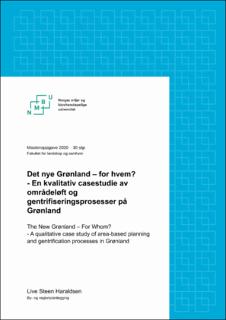| dc.contributor.advisor | Næss, Petter Andreas | |
| dc.contributor.author | Haraldsen, Live Steen | |
| dc.coverage.spatial | Norway, Oslo | en_US |
| dc.date.accessioned | 2021-02-05T14:26:34Z | |
| dc.date.available | 2021-02-05T14:26:34Z | |
| dc.date.issued | 2020 | |
| dc.identifier.uri | https://hdl.handle.net/11250/2726475 | |
| dc.description.abstract | Det nye Grønland – for hvem? er en forskningsstudie som følger områdeløftet på Grønland i Oslo, et løft som er besluttet igangsatt på bakgrunn av områdets status som utsatt byområde i indre øst. Forskningsstudien søker å finne svar på hvorvidt en offentlig initiert byutviklingsstrategi som et løft av Grønland er, vil medføre endringer som sammenfaller med en gentrifiseringsprosess. Og er en slik konsekvens kanskje både tatt høyde for og ønsket? Jeg har gjennomført analyse av offentlige dokumenter knyttet til områdeløftet, samt intervjuer med byforskere og utviklingsagenter i området. I samtale med byforskere og utviklingsagenter har de endringsprosesser som har foregått på Grønland frem til i dag, og hvordan området i dag preges av disse blitt beskrevet. Jeg har foretatt en analyse av deres beskrivelser som viser at disse endringsprosessene har sammenfallende trekk med gentrifiseringsprosesser. Dette gjør at man snakker om en påbegynnende gentrifisering av Grønland, noe Sæter og Ruud (2005) argumenterer for i sine studier av bydel Gamle Oslo. Videre har jeg kartlagt beskrivelser av de aspektene ved området som har ført til at det i dag omtales som et utsatt område, og undersøkt videre forståelser av behovet for et områdeløft. Med utgangspunkt i dette har jeg drøftet hvorvidt områdeløftet er å anse som en løsning på disse utfordringene eller om det er å regne som et offentlig initiert virkemiddel for å skape et gentrifisert Grønland. | en_US |
| dc.description.abstract | The New Grønland - For Whom? is a research study following the area-based initiatives aimed at increasing the status of Grønland which today is considered to be a troubled area on the east side of the inner-city of Oslo. The study seeks to find answers to whether a government-initiated city planning strategy, such as this one, would bring along changes that coincide with a gentrification process. And if so, is the possibility of gentrification as a result of this strategy accounted for, or desired by the government? To answer these questions, I have analyzed public records regarding these initiatives and conducted interviews of both researchers on the matters and local stakeholders. The interviews gave insight into how the development process taking place over the years and still going on today is affecting the area. Analyzing their accounts shows strong indications that the development process correlates with a gentrification process. This means we are now talking about an initiated gentrification of Grønland, as stated by Sæter and Ruud (2005) in their study of the urban district of Gamle Oslo. Furthermore, I have documented the aspects that have caused this area to be viewed as troubled, and also the understanding of the necessity of an area-lift. Based on these facts and findings, I have discussed whether this area development is a good solution for the existing problems, or if this is to be considered as a government-initiated effort to create a gentrified Grønland. | en_US |
| dc.language.iso | nob | en_US |
| dc.publisher | Norwegian University of Life Sciences, Ås | en_US |
| dc.rights | Attribution-NonCommercial-NoDerivatives 4.0 Internasjonal | * |
| dc.rights.uri | http://creativecommons.org/licenses/by-nc-nd/4.0/deed.no | * |
| dc.subject | Byutvikling | en_US |
| dc.subject | Grønland | en_US |
| dc.subject | Urban planning | en_US |
| dc.title | Det nye Grønland - for hvem? : en kvalitativ casestudie av områdeløft og gentrifiseringsprosesser på Grønland | en_US |
| dc.title.alternative | The new Grønland - for whom? : a qualitative case study of area-based planning and gentrification processes in Grønland | en_US |
| dc.type | Master thesis | en_US |
| dc.description.localcode | M-BYREG | en_US |

